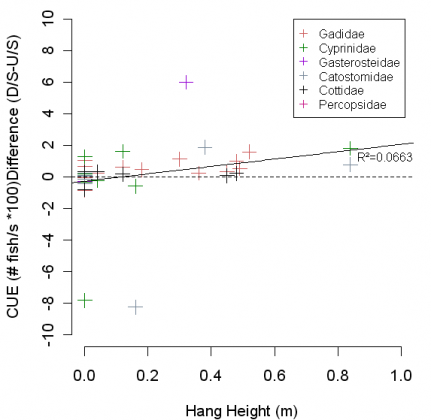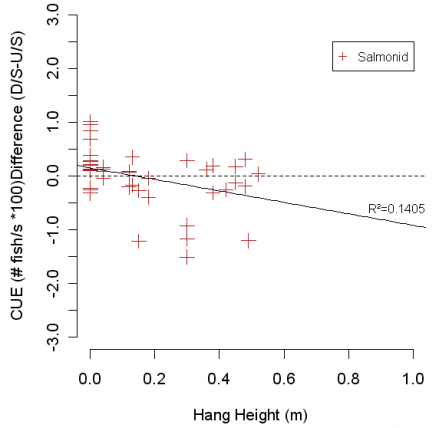1) Does Outlet Hang Height Impede Upstream Fish Passage?
Weak Swimmers
Fig. 3.
Difference (downstream-upstream) in catch per unit effort
(#fish/second) of weak swimming fish species belonging to the families
Gadidae (burbot), Cyprinidae (northern red belly dace, pearl dace, lake
chub, long nose dace), Gasterosteidae (brook stickleback), Catostomidae
(longnose sucker, white sucker), Cottidae (spoonhead sculpin),
Percopsidiae (trout perch) at culvert stream crossings. A positive
value indicates that at a site more fish of a particular species were
found downstream of a stream crossing, while a positive value indicates
higher presence of a species upstream of a stream crossing.
In
this study bridges were used as control sites. There is a slightly
higher downstream catch rates of weaker swimming fish species as hang
height at a culvert outlet increases. However, only approximately 7
percent of the variation in the data is explained by outlet hang height
(R2=0.0663).
Since this is a weak relationship, it appears that culvert hang height
is not an extremely strong predictor of weaker swimming fish species
catch rates.
Strong Swimmers
Fig. 4.
Difference (downstream-upstream) in catch per unit effort
(#fish/second) of strong swimming fish species belonging to the family
Salmonidae (rainbow trout, mountain whitefish, arctic grayling) at
culvert stream crossings. A positive value indicates that at a site
more fish of a particular species were found downstream of a stream
crossing, while a positive value indicates higher presence of a species
upstream of a stream crossing.
Again, bridges
were used as a control to culvert stream crossing structures.
Downstream catch rates decreased as outlet hang height increased in the
stronger swimming Salmonids. Similar to the weak swimmers, there was a
weak relationship between hang height and catch per unit effort, with
approximately 14 percent of the variation being explained by outlet
hang height (R2=0.1405). It is possible that culvert hang height is not the strongest predictor of strong swimming fish species catch rates.



